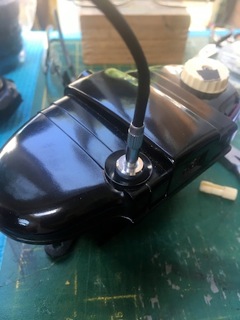A Kodak
Model 0 Box Brownie complete with film was my gateway into the world of 127. There
was no way of telling when the camera had been loaded but most of the Kodak
Verichrome was well and truly stuck to its backing paper and sadly it wasn’t
possible to recover any original images. However, the final, undamaged section
of film did yield something magical and captivating. The frame number and lettering
from the backing paper had been superimposed on the photograph I took of my
washing line.
That this
little black wooden and cardboard box could produce an image of such character
mightily impressed me. Then I found out just how scarce and costly each of the 8
frames of a 127 film would be!
Elevated
by the very occasional ‘treat’ of a genuine roll of Rera Pan 100, I was content
to spool and shoot my DIY rolls. However, little by little I found myself becoming
frustrated by slow shutter speeds and relatively light bodies. I began to feel
that camera shake would stop me getting the best from my cameras. The obvious
solution of course, would be to use a tripod and cable release but many of the consumer
level 127 cameras, such as the Brownies, lack this sort of refinement.
The
modification was pretty straightforward. The film chamber at the shutter
release side of the camera allows plenty of room for drilling a hole to receive
the tripod socket. Before starting I masked off the lens and shutter housing,
and it’s a good idea to make a pilot hole to prevent the drill bit sliding
around and scratching the Bakelite surface. After drilling, I used small files
to clean up the hole (alternatively, you could use sandpaper). To avoid any
light leaks, as well as gluing the socket in place I used epoxy cement to fill
any small gaps around it and over it where it extended inside the camera. A
rubber tap washer provides a nice cushion for when the camera is attached to
the tripod.
The
cable release was even easier. The white plastic shutter button can be pushed
out from the inside, leaving a hole that’s an almost perfect size for a
threaded socket. Epoxy cement was used to fix the threaded socket in place.
Having left everything to set overnight I gave the camera a quick going over,
inside and out, with the vacuum cleaner and a damp cloth to get rid of any dust
or debris from the drilling and filing. All I needed now was a fine day and a
trip to a local riverside village to test things out. I was pleased with the
results that the tripod enabled and relieved to find that having a cable
instead of a shutter button was no hindrance to using the camera hand held.
This has
been an enjoyable and rewarding project and given the really very minimal outlay
(I think I paid £1.50 for the camera; the threaded sockets for the tripod and
cable release were salvaged from the dead camera box; the rubber tap washer was
lurking at the bottom of my tool chest and I already had the adhesives), if it
all went pear shaped I didn’t have much to lose. I also discovered that ‘T-Cut
Scratch Remover’ is a great medium for reviving tired and dull Bakelite!
I don't
possess a light meter. I really like reviving and using old cameras so in fact
I haven't used a camera with a meter for quite a long time - although I do have
a favourite 35mm compact that I use from time to time. My technique for taking
photos with the Brownie is to more or less look at the sky, press the shutter
and hope for the best! I pick the days when the conditions (sunny 16s/11s/8s)
will be just about right for the camera and film I'm going to use. I’ve found that ISO 125 film seems to work
well with the fixed shutter speeds and apertures commonly found on older
cameras. Being consistent with my choice of film gives me a reasonable clue
about the range of tones I'm going to get when I've developed the negs. I
sometimes use a yellow filter if it's going to suit the conditions. I've found
it's true that black and white film is very forgiving and I know I'll be able
to make any adjustments to exposure, contrast etc. with the editing software on
my computer. So with one shutter speed,
one aperture, and one film speed, then it's all about letting the subject,
composition and light do the work. It's quite liberating really.
Update, July 18, 2021, in response to Steve's question (see below):











